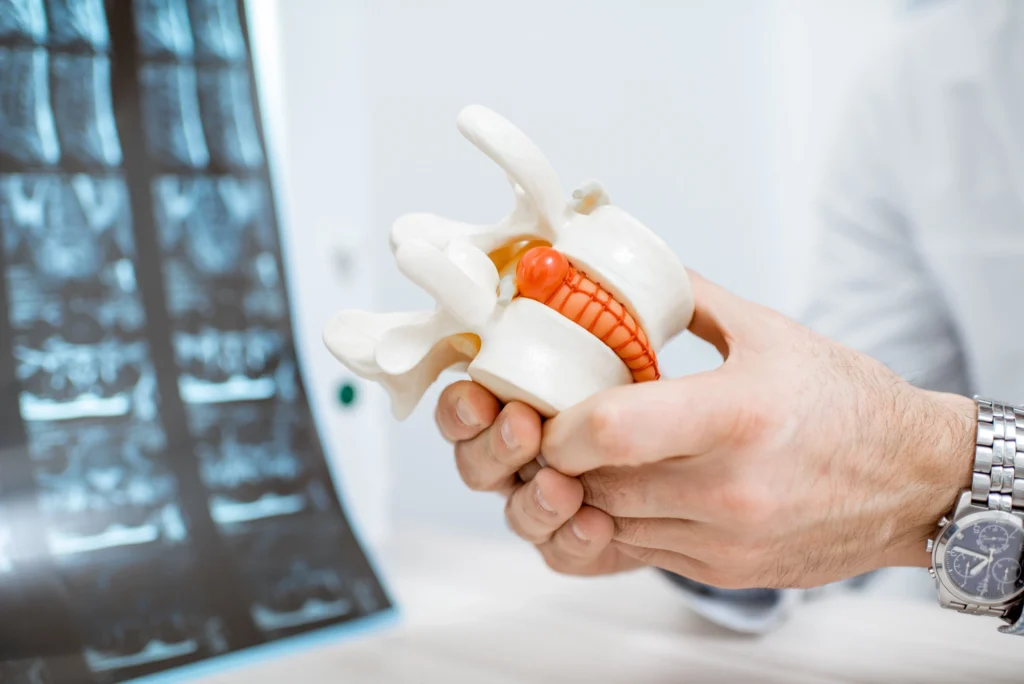
Table of Contents
ToggleIf you are suffering from back pain and have been told that disc replacement surgery can help, then this article will guide you through the process.
It will go into detail about what a disc replacement is and how it works, who is a candidate for this surgery, why it might be recommended over other options (such as fusion), what’s involved in the procedure itself, how long recovery takes and what results patients can expect from having had their discs replaced.
Disc replacement surgery is a minimally invasive procedure that replaces the damaged discs in your spine with artificial ones.
The artificial discs are made of metal and plastic, and they can be placed inside your body through an incision at the abdomen.
Disc replacement surgery can be used to treat severe back pain caused by a herniated disc, which is when part of a spinal disc breaks away from its attachment point and presses against nearby nerves. This type of injury causes severe pain throughout various parts of your body, including arms or legs.
The spine is a complex structure that allows us to stand up, sit down and move around. It also protects our spinal cord as well as the nerves that connect to all of our organs and muscles.
But sometimes, due to injury or degeneration, it can’t do its job anymore. That’s where disc replacement surgery comes in!
Disc replacement surgery is a minimally invasive procedure that replaces the disc with an artificial one. The artificial disc is made of metal and plastic, and it’s placed between your vertebrae to restore height.
The surgery can be done through a small incision in the abdomen which allows the surgeon to access your spine without moving the nerves.

If you’re suffering from back pain, you may be a candidate for disc replacement surgery.
You may be a candidate for disk replacement surgery if you:
Spine surgery is a serious procedure, and as with all other surgeries, it carries some risks.
The risks of this surgery include:
Depending on your medical condition, there may be other risks. Be sure you understand the risks and benefits of lumbar disk replacement before the procedure.

Fusion surgery is performed when the pain caused by your degenerated disc and/or disc herniation is severe enough to interfere with day-to-day activities.
With this type of procedure, a surgeon removes the damaged disc and replaces it with bone grafts from another area of the body (usually from the patient’s hip). The two vertebrae are then fused together in order to prevent motion between them.
The risks associated with fusion surgery include infection and nerve damage as well as other complications that may occur during any major operation on your back or neck area.
There are also some long-term side effects associated with fusion surgery including stiffness in your joints due to limited flexibility after being immobilized during recovery time following surgery; however, these issues can often be managed successfully by following instructions provided by your surgeon regarding postoperative exercises designed specifically for this purpose.
Recovery time varies from patient to patient. It’s dependent on the type of surgery and whether you’re having a fusion or disc replacement. Your age, health and activity level will all affect how long it takes for you to recover after spine surgery.
The recovery time after disc replacement depends on how much pain you were experiencing before surgery. You may be able to return to work within three weeks if your job doesn’t require heavy lifting or strenuous activity. If you were in severe pain before surgery and can’t stand up straight without support, you may need six months to recover fully.
The length of your hospital stay will depend on the type and severity of your condition. The average length of stay is one to two days, but it can be longer if you have other medical conditions or complications that require additional treatment.
Once you’ve been discharged from the hospital, your doctor will schedule follow-up visits with physical therapy as well as occupational therapy to help restore mobility and strength in affected areas. Your physician may also recommend attending pain management classes or counseling sessions if necessary.
In conclusion, opting for spine disc replacement surgery is a significant choice that warrants thorough consideration.
It is crucial to be well-informed and explore all available options to make the best decision for your health and well-being.
We hope this guide provided valuable insights into the subject of disc replacement surgery and equipped you with essential information to aid in your decision-making process.
GET IN TOUCH +
285 Sills Road
Building 5-6, Suite E
East Patchogue, NY 11772
(631) 475-5511
184 N. Belle Mead Road
East Setauket, NY 11733
(631) 675-6226
GET IN TOUCH +
285 Sills Road
Building 5-6, Suite E
East Patchogue, NY 11772
(631) 475-5511
184 N. Belle Mead Road
East Setauket, NY 11733
(631) 675-6226
SUBSCRIBE TO OUR NEWSLETTER +
Send us a Google review. Click this link and let us know how we did!
Review us on Yelp too.